The PNY CS1311 and CS2211 SSD Review: MLC vs TLC at 15nm
by Billy Tallis on April 15, 2016 8:00 AM ESTMixed Random Read/Write Performance
The mixed random I/O benchmark starts with a pure read test and gradually increases the proportion of writes, finishing with pure writes. The queue depth is 3 for the entire test and each subtest lasts for 3 minutes, for a total test duration of 18 minutes. As with the pure random write test, this test is restricted to a 16GB span of the drive, which is empty save for the 16GB test file.
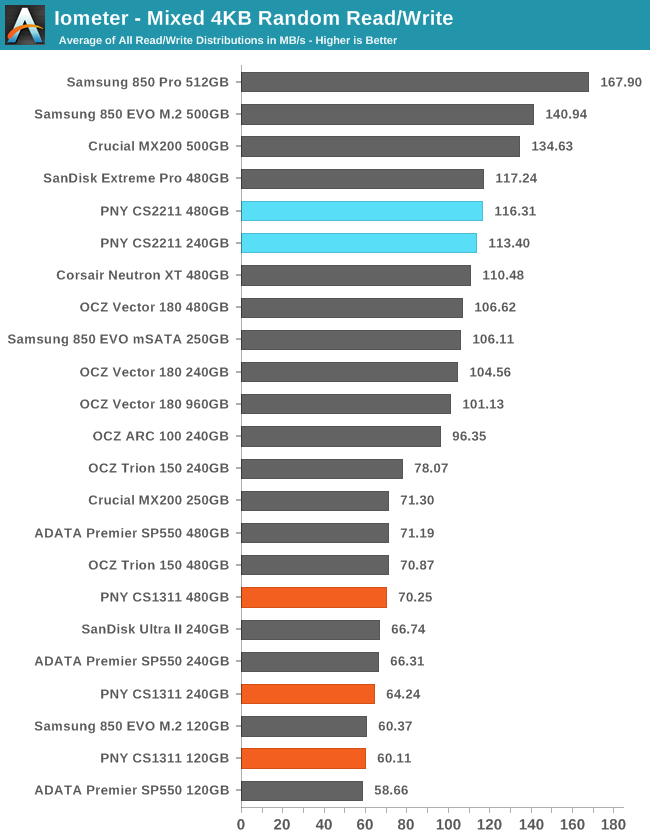
The mixed random I/O performance of the CS2211 is a little above average for MLC drives, while the CS1311 is pretty much at par for a planar TLC drive.
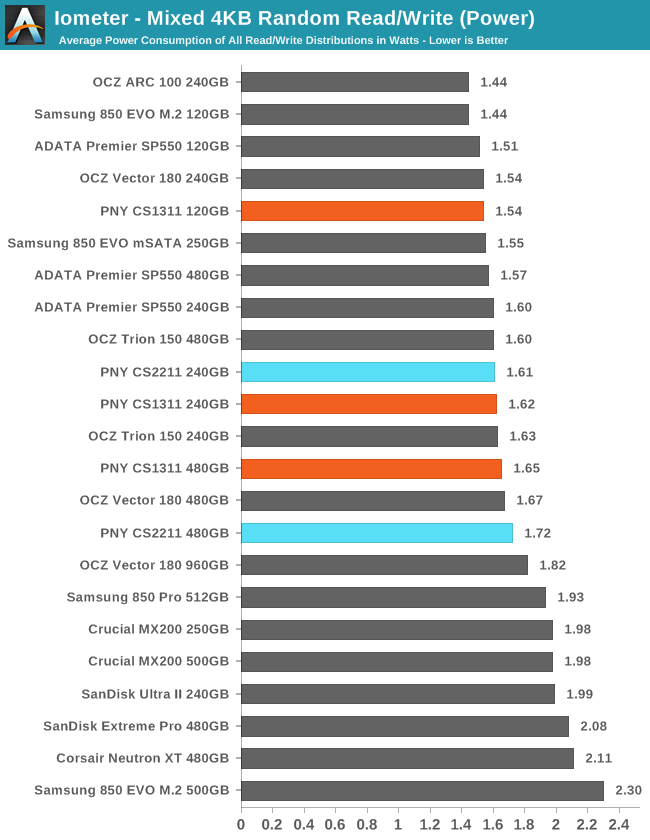
Power draw on the mixed random test follows the same patterns we've been seeing: the slowest and smallest drive draws the least power, while the largest fastest drive draws the most. All of the PNY drives are in the average range for power consumption, and the MLC drives are significantly more efficient.
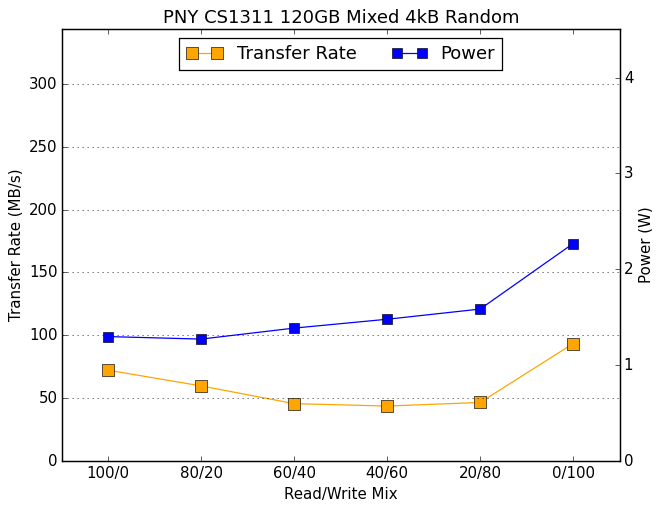 |
|||||||||
It's typical for power consumption to increase over the course of this test while performance bottoms out somewhere in the middle. The biggest difference in character between the TLC and MLC drives from PNY is that the MLC drives get a huge boost in the all-writes last phase of the test, bringing their average score way up.
Mixed Sequential Read/Write Performance
The mixed sequential access test covers the entire span of the drive and uses a queue depth of one. It starts with a pure read test and gradually increases the proportion of writes, finishing with pure writes. Each subtest lasts for 3 minutes, for a total test duration of 18 minutes. The drive is filled before the test starts.
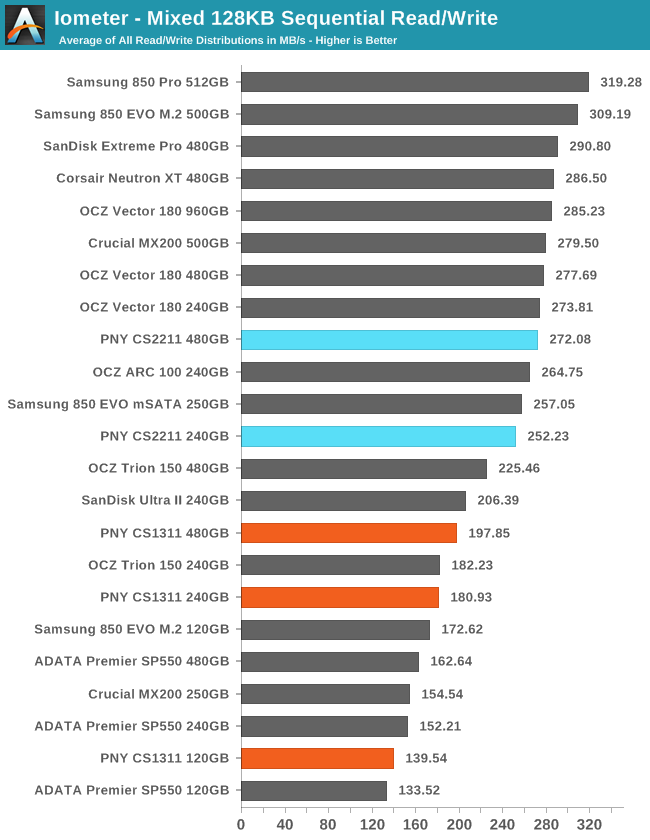
On the mixed sequential I/O test, PNY's drives range from slightly above average to second worst. The 240GB CS2211 in particular is underperforming a bit compared to its competition while the 480GB OCZ Trion 150 performs surprisingly well compared to the other TLC drives (including the 480GB CS1311).
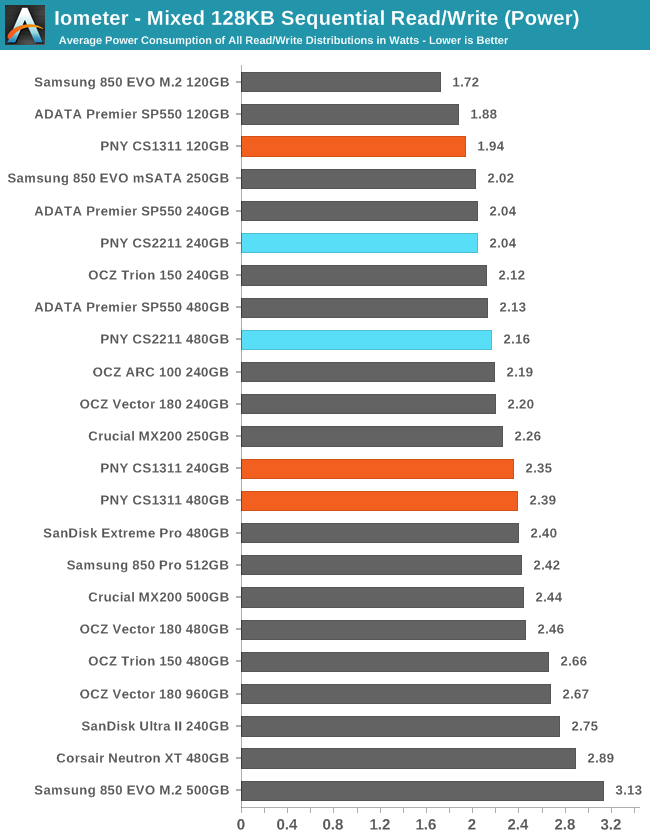
Both of the CS2211s average lower power consumption than the CS1311s of the same capacity, while the slower 120GB CS1311 again comes in as the least power-hungry of the batch (though its efficiency is nothing praiseworthy).
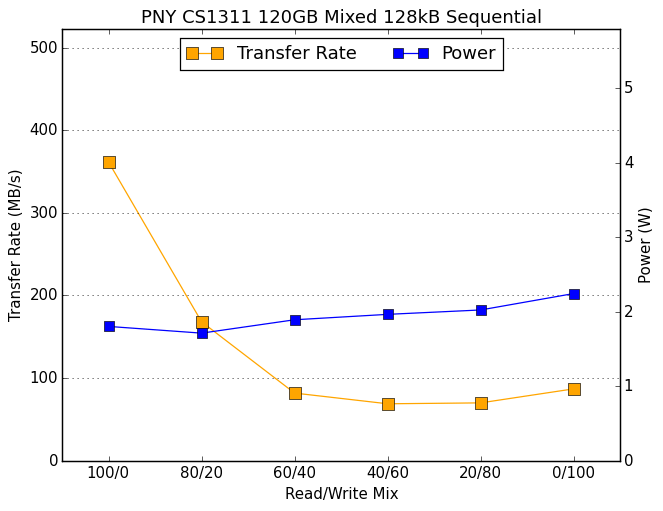 |
|||||||||
The key factor in the 120GB CS1311's low power consumption is its low performance on the pure-write phase of the test, which is an unsurprising result. The other CS1311s are large enough to deliver significantly higher performance on that part of the test, but they pay the cost in increased power draw.










43 Comments
View All Comments
alexdi - Friday, April 15, 2016 - link
I read this with only one question in mind: does it beat the 850 Evo? Save for a few ticks in power usage, apparently not. The Evo is perpetually on sale. I've yet to see a compelling reason to opt for anything else on a desktop.ingwe - Friday, April 15, 2016 - link
Completely agree. I am not tied to it, but I don't see any reason to recommend pretty much anything else.fierywater - Friday, April 15, 2016 - link
The CS1311 gets marked down from time to time; I picked up my 480GB one for $100 while the Evo 850 500GB usually doesn't get marked down below $130 (and it was $150 everywhere when I picked up the CS1311). It's plenty fast for real world use, especially as a drop-in replacement for an HDD. I think there's a place for drives like it, although that applies less to the CS2211.lilmoe - Friday, April 15, 2016 - link
For the performance and value you're getting with the EVO, $30 is well worth the extra, and hardly an amount worth saving going for the CS1311, or any other TLC drives at that. In the matter of fact, lots of the current consumer MLC drives don't compare to the value, performance, or in some cases, the endurance and features you're getting with the EVO.ATC9001 - Monday, April 18, 2016 - link
I agree from most "prosumers" which are frequent to read this article, but for the mainstream user, I don't think its worth it (spending the $30+). Any SSD is better than a HDD, but some garbage bargain bin SSDs aren't worth the cheap price (this being the first exception). I know most people (including myself) think the same thing alexdi posted when reading this....is this going to beat the evo? It doesn't, but at the same time it's not far off from it, and $30 bucks can cause it to break a price plane for some mid range users.Each person has there own utility curve or price performance idea, and for me, this is the first drive since the 840 EVO was released in which I would say it's not worth the x dollars to just get the evo!
Stuka87 - Friday, April 15, 2016 - link
Having a quality, reliable drive is not reason enough for you? If you want to buy a drive that has a much shorter life span, go for it. But Anybody that cares about data, is not going to by a TLC drive over a MLC drive.lilmoe - Friday, April 15, 2016 - link
FYI, TLC VNAND has better endurance than most 15nm MLC drives...Impulses - Friday, April 15, 2016 - link
Define much shorter...You're talking in broad strokes about a bunch of different things in the same breath. Life span and reliability aren't necessarily the same thing, unless you need drives to be reliable for 15yrs...
15yrs ago I was wondering if I'd ever fill my 75GB Deathstar, I'm not sure I'd even keep a drive 5+ years. My 2x 850 EVO have been nothing but reliable since I bought them last year.
DanoSpumoni - Friday, April 15, 2016 - link
Same here. the M.2 850 EVO 500GB is my go to SSD right now. They are in all my computers either in M.2 slots or M.2-> SATA sleds. The performance and reliability is hard to beat. I only buy M.2 SSDs now for future compatibility because they last so long I know they'll outlive the computers they inhabit right now. When the 1TB version drops to ~$150 I'll grab some more...Impulses - Friday, April 15, 2016 - link
I'm sitting on 2x 1TB, bought at like $310 & $330 IIRC, seen them for $260 lately... Waiting for the 2TB to drop lower and I might add one of those. :D